HISTORY
In 1962 Walter Shealy bought his first registered heifer, Paycheck Ermine, as a 4-H project. As his herd grew he realized that he needed more pasture. When he was 13 years old, he and his county extension agent, Ollie Dunkle, paid a fruitful visit to a widow lady in Newberry, SC. The two were there to see what the chances were that she might lease an enthusiastic, enterprising young man (Walter) her 44-acre farm to house his growing 4-H project – Angus cattle. When he turned 16 the lady decided to sell the farm. Walter approached a local banker to apply for a loan to purchase the land. Even as a youth, Walter always had a plan and a strong work ethic. He picked up pecans, ran paper routes, and worked odd construction jobs to support the 4-H project. He convinced the local banker that he could repay the loan by executing his business plan to rent the house, sell his calves, hay, pecan crop and by working after-school/summer jobs. Apparently Walter was convincing, and more than 59 years later, Walter Shealy is still raising Angus cattle on that same tract of land, now known as Black Grove.
Walter's interest in Angus cattle began with showing Angus heifers in 4-H. He credits much of his early successes with his projects to his mentors, Ollie Dunkle, and his parents' encouragement. He was an original member of the SC Junior Angus Association. While his passion has always been Angus cattle, Walter's family history is a story in itself that might shed some light on how he came to be the successful businessman, community leader, and top-notch cattleman that he is today.
When Walter's father was 36 years old he had built a successful ice cream business in Charleston, SC. It was then that he became a Christian, and decided to complete his education. He obtained his high school and college degrees over the next four years and subsequently becoming a minister at an inner city church in Greenville, SC. He saw troubled children and youth and thought how much they could benefit from growing up in a rural environment versus the inner city. In 1960, the Shealys sold everything they had and moved to Newberry, SC, to begin the Boys Farm. Fifty-eight years later more than 600 boys have benefited simply because this couple saw a need and put into action what most folks wouldn't have the courage to do. Today, the Boys Farm (click here for more information) is a growing, non-denominational, privately-funded mission that operates in the black. Farm animals include registered Angus cattle, horses, goats, and chickens. With some help from the Newberry Cattleman's Association, the boys have the opportunity to show goats, steers, and heifers as 4-H projects and earn scholarships for their efforts.
Walter was 11 years old when his family moved to Newberry. He grew up at Boys Farm, with two roommates and "lots of brothers" over the years, many with whom he has stayed in touch. Walter credits his resourcefulness to run a cattle farm as a teenager to the values of family, hard work, personal and financial discipline and sacrifice, love and respect for family and friends and God's creatures, that were instilled in him and the other children growing up at Boys Farm. Add financial necessity and you have a formula for success.
Walter's entrance into the beef cattle world was blessed with good fortune and his first four brood cows produced a total of 13 consecutive heifer calves to result in a nice-sized herd in a short period of time. The local Purina dealership noted Walter's enthusiasm and love of cattle. They recommended Walter Shealy, for the Ralston Purina Youth of the Year Award which he received in 1965.
In addition to his odd jobs and his farm, Walter managed to play three sports in high school. And quite proficiently it seems, as he was asked to play football at Presbyterian College in Clinton, where he met his future wife, Jean. While Walter loved football, it took some prodding from family and friends to persuade him that he should go to college. He leased his beloved cattle to a family friend, Dale Owens, for five years and while in college he worked a part-time job at the very farm his friend managed, conveniently allowing him to keep a close eye on his Angus herd.
Walter completed college and was off to enter the banking business in Atlanta. After career moves to Los Angeles, CA, and Milwaukee, WI, he settled in Miami, FL, in 1984 where he became president of a $2.5 billion savings bank which grew to $10 billion before resigning in 1989. He subsequently founded his strategic consulting company, WDS Investments, Inc. in 1989. All the while Walter kept adding acreage to his farm in Newberry, now totaling almost 400 acres, which he visited as frequently as his businesses would allow. As an absentee owner, Walter is convinced that his herd developed strong survival genetics and hardiness during his time away. In 1989, Walter and Jean began making plans to make a permanent move to Newberry. Walter wanted his sons, Dixon and Russell, to finish understanding their heritage and enjoying the benefits of living in a rural environment. Over the past 56 years, the family has operated Black Grove without ever hiring a full time manager or employee. In 1994, they returned to remodel and live in the very house that was on the original 44-acre tract that Walter rented and subsequently bought as a 16-year-old boy. Today, Walter is Chairman and chief executive officer of Shealy Consulting Group and Black Grove LLC. Go to LinkedIn for more information on Walter's other business activities. His responsibilities still require him to travel with Dixon helping on the weekends and Jean continues to handle the accounting. Walter manages to spend as much time as possible in Newberry surrounded by Angus cattle, his family, their heritage, and the Boys Farm.
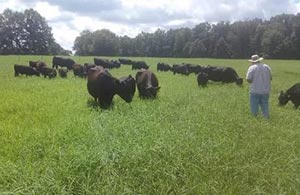 Today around 75 breeding-age Angus females make up the nucleus of the registered cattle at Black Grove. Walter has heavily focused on using Embryo Transfer (ET) in his program and has 15 donor cows. Black Grove contracts with several commercial cattlemen to raise part of their ET Angus calves until weaning.
Today around 75 breeding-age Angus females make up the nucleus of the registered cattle at Black Grove. Walter has heavily focused on using Embryo Transfer (ET) in his program and has 15 donor cows. Black Grove contracts with several commercial cattlemen to raise part of their ET Angus calves until weaning.
Walter's breeding philosophy is short and sweet – "Fundamentals survive fads." He breeds catlle from proven genetics using multiple-trait selection criteria including: fertility, phenotype, low input identifiers, longevity analysis, performance EPDs, carcass data, and gene markers technology. He looks for cattle with bloodlines from animals that have longevity (a trait not presently measured by the Angus Association). He believes longevity translates into functionality because logic dictates that cows who live a long time would have been culled if they were not functionally sound. If a cow did not produce a calf annually, have good feet, good teeth, a good udder, milk well or maintain her fleshing ability, remain productive or fertile she would have to be culled. Walter's conclusion is if we can breed cattle that function for 12-15 years we will dramatically cut our turnover, thereby cutting the expensive capital cost of raising replacement heifers in half.
To that end, Black Grove has developed a new longevity trait selection index which allows us to identify animals that should have an increased probability of living longer. The result is less turnover of productive females (our factories), lower capital investment in replacement heifers, and therefore, higher profitability and improved return on investment. We believe longevity/functionality is one of the most important selection traits for any commercial or registered cow-calf operation. To achieve this Black Grove targetted genetics from the following cows including but not limited to H 96 Black Belle 442, Sitz Everelda Entense 1905, Brooks Donna 403, G D A R Forever Lady 98, N Bar Enchantress 4908, Ideal 4465 of 6807 4286 and V D A R Polly 215.
On our Longevity page, you will find an explanation of the Black Grove Longevity Trait Selection Index. All Black Grove females offered in our future sales will be ranked using a simple one to five star system derived from mathematical formulas which have been reviewed and validated by an actuary.
In addition he also looks for cows that are low input, and productive on food sources of only grass and hay, are low maintenance, structurally sound, calve easily, have strong maternal instincts, easy fleshing (energy efficient) and docile. Cattle with these characteristics have proven to perform well in our high stress Southeastern environment which is dominated by hot, humid drought ridden summers and fungus-infected fescue grazing in the winter. Walter said, "Our culling criteria is simple, we don't reproduce those cattle that don't work for us in our environment."
Within the Black Grove herd, one can find the genetics from Angus cow families that are proven efficient low input cattle that do not need to be fed silage or feed year round in order to perform. A prime example is the Black Belle cow family from the great H 96 Black Belle 442 and Black Grove Black Belle 110 which have 38 descendents in the Black Grove Herd. In addition, Walter has bred a number of promising young herd sires that also thrive in this environment. For more information go to our sires page.
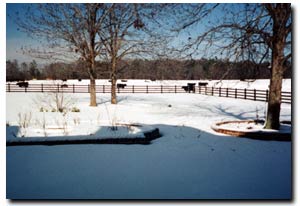 Since his return to the ranch, Black Grove has had four production sales beginning in 2002. The 2006 sale featured the all-time record-selling female in South Carolina, Castle Hill Erica C035, the greatest full sister to Leachman Right Time. She sold for $60,000, one-half interest ($120,000 valuation) to Sauk Valley Angus in Illinois. The goodwill from 63 years breeding Angus cattle translated into cattle being sold into 15 states. The Black Grove herd is now recognized as one of the most unique low input / longevity programs in the country focusing on proven maternal traits.
Since his return to the ranch, Black Grove has had four production sales beginning in 2002. The 2006 sale featured the all-time record-selling female in South Carolina, Castle Hill Erica C035, the greatest full sister to Leachman Right Time. She sold for $60,000, one-half interest ($120,000 valuation) to Sauk Valley Angus in Illinois. The goodwill from 63 years breeding Angus cattle translated into cattle being sold into 15 states. The Black Grove herd is now recognized as one of the most unique low input / longevity programs in the country focusing on proven maternal traits.
In 2014 Black Grove partnered with Springlake Angus in Lynch, NE, the Legacy herd for RR Rito 707 genetics, to expand our core bloodlines. The cattle from these two historic herds are performing extremely well in both regions of the country.
Walter sees the beef business as an exciting playing field with tremendous strides being made in the scientific research arenas. Feed conversion and longevity are subjects that Walter has a great deal of interest in and as a former banker, he is well aware that these are two of the largest cost components of producing beef. He hopes the American Angus Association will work with private researchers and universities to address these subjects taking into consideration the environmental differences in each region of the country.
The Angus Association has the cattle industry’s most sophisticated data base. But Walter believes there is a bias towards new generations of genetics in the Association’s software, similar to that which existed in the dairy industry’s software and a negative bias against older proven material genetics. This is validated by the Association twice discounting the EPD’s of the older proven cattle. He believes the Association’s embracing DNA technology equally with actual performance data is key long term to providing even more balanced information and projections.
The two primary types of cattle in the breed are terminal and maternal.
Terminal Trait (High Input) cattle with the largest Milk and Marbling EPD’s and $B numbers or the highest growth EPD’s may be ideal for the feed lots and CAB. But they require high feed input and they are not the most profitable or functional genetics for cow calf operations. Both bulls and heifer calves out of terminal genetics should be sent to the feed lots.
Maternal Trait (Low Input) cattle will be more moderate in size and numbers focusing on fertility, weaning EPD, $W, high $EN, feed efficiency and longevity (functionality, fertility feet, udders). They are less expensive and more profitable to run and therefore they are ideal for cow calf operations and the grasslands of our hemisphere. Maternal trait cattle should be chosen for replacement heifers and one’s mature cow herd.
He would also like the Association to be more supportive of the various types of cattle we need in the different environments in which the membership operates. Value creation for our members is a function of one’s return on investment in one’s own environment.
About twenty years ago Walter’s older son Dixon returned to the farm. He serves as a manager and herdsman. For 17 years he has been instrumental in improving many of our practices and intellectually pushing us to experiment and challenge or validate our theories. He also worked closely with Clemson University on many aspects of our operation. In 2014 he was named to the Clemson University Bull Test Committee and served as its chairman. In 2015 Dixon was elected to the SC Angus Association Board of Directors and in 2016 he was elected Vice President and Sale manager of the SC Angus Futurity and in 2018 he was elected President of the SC Angus Association. Unfortunately Dixon had an accident in 2022 and had to retire from managing the ranch.
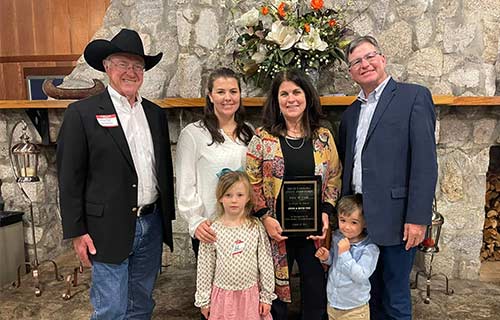 Walter Shealy with the Yon Family during the Yon Family induction into South Carolina Angus Association Hall of Fame
Walter Shealy with the Yon Family during the Yon Family induction into South Carolina Angus Association Hall of Fame
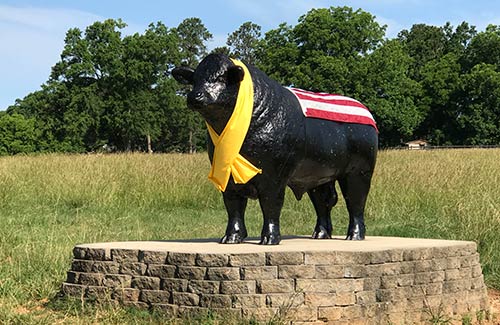 In 2012 there was a new arrival to Black Grove with the addition of the Black Grove Bull Statue. The Bull Statue has turned into a major landmark for Newberry County, South Carolina. This photogenic bull is decorated for each major holiday and welcomes visitors to Black Grove.
In 2012 there was a new arrival to Black Grove with the addition of the Black Grove Bull Statue. The Bull Statue has turned into a major landmark for Newberry County, South Carolina. This photogenic bull is decorated for each major holiday and welcomes visitors to Black Grove.
In 2013 Black Grove received the Conservationist of the Year Award and we continue to work on sustainability of our ranch, our herd and our family heritage.
Dixon gets a kick out of teasing Walter about working his dad hard on the weekends. He tells Walter that free labor is hard to get and he was going to take advantage of it when he could. Like most families in the cattle business we all pitch in when needed. Russell, our younger son is an excellent cowboy and he helps whenever he is in town and we need him. He is always in the ring on sale day. Their mother, Jean a city girl, has become a good hand over the years. She is always accounting for and collecting the money.
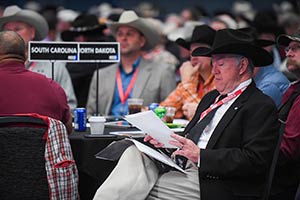 Over the past couple of decades Walter has been elected to represent his fellow SC Angus breeders as one of their delegates to the American Angus Association National Convention, an honor of which he is very proud. In recognition of all the contributions he has given the South Carolina Angus Association, the Angus breed and the community, the South Carolina Angus Association dedicated the 2015 South Carolina Angus Futurity to Walter.
Over the past couple of decades Walter has been elected to represent his fellow SC Angus breeders as one of their delegates to the American Angus Association National Convention, an honor of which he is very proud. In recognition of all the contributions he has given the South Carolina Angus Association, the Angus breed and the community, the South Carolina Angus Association dedicated the 2015 South Carolina Angus Futurity to Walter.
Walter sees the beef business as an exciting playing field full of challenges and opportunities. In his spare time he serves as Chairman of the Board at Boys Farm, Inc., and Chairman of the SC Angus Association Hall of Fame committee. He previuosly served as President of the SC Angius Association, was a member of the executive committee of the board of directors of the SC Cattlemens’s Association, served on the Board of Trustees at Presbyterian College, served as a Trustee for the South Carolina Independent Colleges and Universities, served on the Newberry Opera House Board of Directors, and coached numerous athletic teams over the years including Post 24 American Legion baseball team. He is a member of the First Presbyterian Church, and is a proud father of two sons, their wives and two granddaughters, a grandson and a devouted husband to his wife Jean.